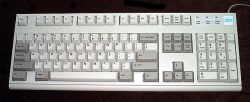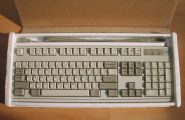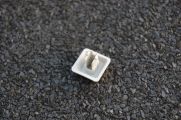IBM Selectric Touch Keyboard
| This article requires additional photographic illustration |
 | |
| Part number |
1395300 (US M2) 60G3570 (US M1) 42H0468 (US 3153) 60G0817 (US rubber dome with border) Others |
|---|---|
| FCC ID | IYL1398800 |
| Branding | IBM, Lexmark, Eduquest |
| Manufacturer | IBM OPD, IBM UK, Lexmark |
| Layouts | 101-key ANSI or 102-key ISO |
| Keyswitches | Buckling spring over membrane |
| Interface | PS/2, 3151 RJ-45 |
| Dimensions |
451 × 158 × 38 mm (17.76 × 6.22 × 1.5 inches)<ref name=G520-9415-02/> (M2, 3153 style) |
| Weight | 0.9 kg (2 lbs) |
| Years of production | 1990–1995 |
| Price | $177 (1992)<ref name="PCMag-19920225" /> |
The IBM Selectric Touch (more commonly known by the manufacturing designation Model M2) was a low-cost and lightweight buckling spring keyboard for IBM's PS/1 - a home computer released in 1990. The keyboard was also used with the later PS Value Point. A variant of the M2 was used as the keyboard of the IBM 3153 terminal, and attached to the terminal by means of an RJ-45 connector. Also related was the Model M1 which was the same as the M2, except sold through IBM's 'Options by IBM' branding as opposed to being bundled with an IBM computer. There were also rubber dome versions.
Design[edit | edit source]
Whereas most buckling spring variants were based on the design of the IBM Enhanced Keyboard, the M2 was a completely new design of buckling spring keyboard with very little in common with other Model M derivatives. Whereas other buckling spring keyboards consisted of a barrel housing with attached metal backplate housed inside a plastic case, the M2 used a simple two-piece snap-together casing. It dispensed with the metal backplate, and instead had the membrane sitting on a layer of insulating foil on the bottom half of the casing. The upper half of the casing had the barrel housings built into it. The result was a lightweight and compact keyboard. The controller was located directly under the lock light area of the keyboard, and was pressed onto the membrane using plastic clips, and interfaced with the membrane with contacts on its underside. In some ways, the controller is not unlike the style used in the later 42H1292-style Enhanced Keyboard.
The keycaps were of a different, incompatible type to the regular Model M ones. They were lower profile, and had a shorter and narrower stem. They were still made of PBT and still used dye sublimation printing. Somewhat unusually, the large keys had stabilizer bars made out of plastic. The keyboard was attached to the computer with a flat, straight, non-removable cable with a PS/2 connector, except for terminal versions which used an RJ-45 connector. The terminal version is fully PS/2 compatible, and merely needs a passive adapter to map the RJ-45 pins to the appropriate PS/2 ones.
In addition to buckling spring keyboards, a number of rubber dome variants were made. Most common was a version with a large detachable plastic border around it, which was most commonly associated with computers that IBM sold to the educational sector. There were also ones without the border, but these are far less common.
Longevity issues[edit | edit source]
The M2 is well known for electronics problems. The electrolytic capacitors in the logic board are prone to failure, possibly due to IBM's use of early surface mount technology in the production of the controller board. Failure usually occurs after long periods of not being used. The usual method of diagnosing capacitor failure is that the Caps and Scroll Lock LEDs stay on whilst the keyboard doesn't respond to keypresses. However, there are guides to replacing the capacitors (see below) which appear to solve these issues.
Some parts of the M2 are particularly fragile. When disassembling, care should be taken to ensure that the plastic key stabilizers do not snap. Similarly, the plastic clips holding the controller board onto the membrane are (very) easily broken.
It appears that at least three PCB suppliers were used. One was provided by Wong's and bears their logo.<ref name="DT-Wongs" /> These have the manufacture date marked in white silkscreen printing. A second variant has no obvious branding and the date marked by copper removal.<ref name="DT-anticopper" /> A third type also has a silkscreen-printed date, and branding that is no presently recognised.<ref name="GH-broken" /> It seems that all three PCBs use the same components, and are all vulnerable to the same capacitor failure.
Gallery[edit | edit source]
- M2 Keyboards
-
Standard Model M2, new in box.
-
IBM 3153 Keyboard.
-
Rubber dome M2, showing border.
-
Underside of upper half of M2 case, showing barrel housings.
-
Underside of keycap
-
Keycap off
-
First matrix layer
-
Second matrix layer
References[edit | edit source]
<references> <ref name="G520-9415-02">IBM InfoWindow II 3153 Marketing Reference Guide, Third Edition (US version), dated July 1998 — Page 11 (bitsavers)</ref> <ref name="PCMag-19920225">Google Books — PC Magazine, February 25, 1992 (The Write Stuff, pp. 303–329)</ref> <ref name="DT-Wongs">Deskthority — IBM M2 restoration log - No one left behind!</ref> <ref name="DT-anticopper">Deskthority — IBM Model M2 Plastic Snaps Holding The PCB Board Broken.</ref> <ref name="GH-broken">geekhack — Repairing the IBM Model M2</ref> </references>
External links[edit | edit source]
- Sandy55 — Article on the Model M2
- Instructables — Disassembly guide for the M2
- Geekhack — Guide to replacing the capacitors





